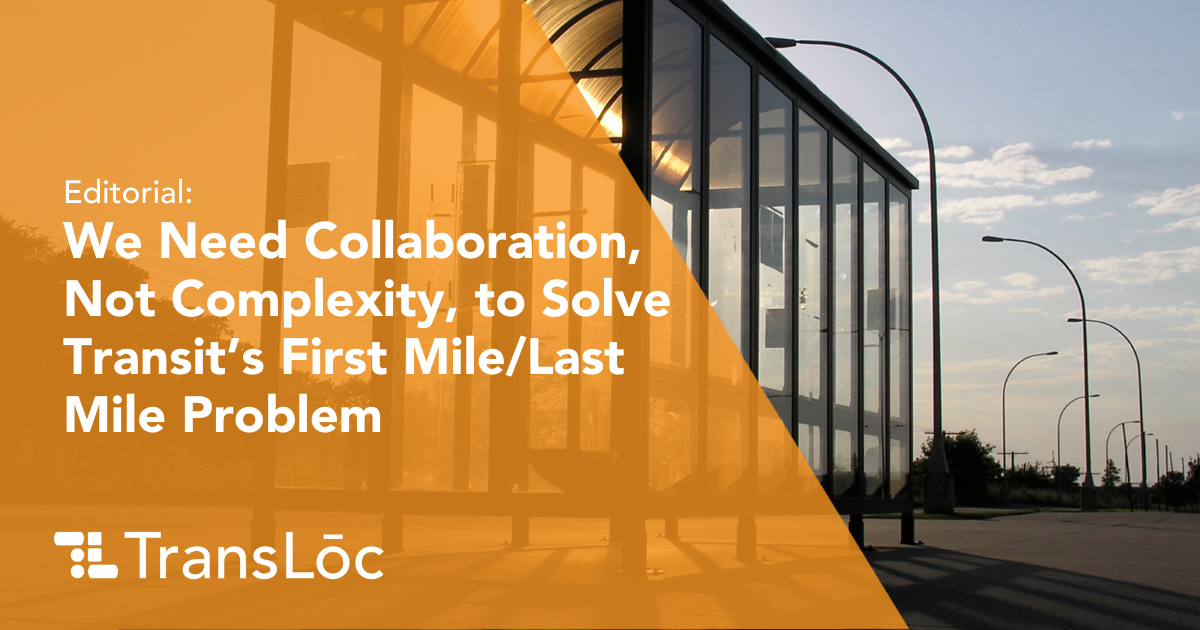
Even though many people continue to rely on public transit, we are seeing a gradual decline in ridership across the country. According to the American Public Transportation Association (APTA), transit ridership declined by 2.9% from ridership levels in 2016, which was already down 3.1% from 2015.
While global health events, service reliability, and roadway congestion influence public perception of transit, the first mile/last mile (FM/LM) problem has always been at the core of attracting or retaining public transit riders — especially choice riders who have the option of using a private vehicle for their transportation needs.
Since traditional fixed-route vehicles are limited to serving predetermined routes in a defined geographical location with established stops, a rider’s journey is often multimodal. In order to board the fixed-route vehicle, a rider may need to walk, bike, or use an on-demand service to get to the nearest stop (a.k.a., the first mile). From there, depending on the rider’s destination, another form of transportation may be required to get them to the end of their journey (a.k.a., the last mile).
The difficulty of a rider’s FM/LM experience is influenced by numerous geographical and socioeconomic factors. Does the rider live in a suburban or rural community miles away from the nearest transit hub? Is the rider unable to walk long-distance due to health ailments? Do they have the financial means to reserve an e-scooter, bike, or ride-hailing services? How long does the rider need to wait between transfers? Being picked up by an on-demand vehicle at your home and transported to the nearest fixed-route stop sounds great, but not if it means waiting over 30 minutes for the next bus to arrive.
In the eyes of riders, FM/LM is an issue of efficiency.
What modes of transportation will get riders to their destination as quickly and safely as possible?
Technology companies, transit agencies, and auto manufacturers are eager to answer that question in a world weighed down by COVID-19 and environmental concerns. We are seeing examples of innovation in mobility sprouting up all over the country. Transportation network companies (TNCs) like Uber and Lyft have never been more popular, even as their fare prices reach the stratosphere. Mobility (and micromobility) solution providers like TransLoc and Spin are putting game-changing technology in the hands of transit agencies to revolutionize their transit services. And every major auto manufacturer is touting electric and autonomous vehicles as an evolutionary leap for safe, efficient, sustainable, and affordable transportation.
It’s undeniable that TNCs, electric vehicles, and autonomous vehicles are important players in solving the FM/LM puzzle, but first we must identify simple and efficient solutions that riders will be able to understand and embrace as the landscape continues to transform. TNC, EV, and AV integration must be presented as an attractive and accessible mobility option. Getting riders back on board means convenient, safe, and clear transit routes along with accessible transit stations and micromobility services.
The intense focus on FM/LM is increasing the need for local agencies to break down silos, establish a unified goal, and collaborate on solutions that help everyone. Every stakeholder — government officials, city planners, community advocates — should have the goal of making investments into transit that increase ridership, promote alternative modes of transportation, and discourage single-occupancy vehicle traffic. For instance, Metropolitan Atlanta Rapid Transit Authority (MARTA) is making a huge push to turn Atlanta into a bike-friendly city. MARTA offers free bike storage at their stations, bike storage racks on all buses, and has widened their station walkways to make it easier for cyclists to navigate through the station. They are a fantastic example of how local agencies can embrace cooperative planning for the betterment of riders.
Technology adoption for transit agencies and riders will continue to accelerate at a rapid pace
Based on recent transportation trends, here’s what the future holds:
- Transit agencies need ways to accurately predict rider demand hour-by-hour. Matching deployment of agency assets to meet demand requires advanced analytics and transportation planning (as well as giving your riders multiple platforms to share their opinions).
- Riders want simplicity and smart integration from their transit tech. One comprehensive app for access to multimodal transportation services, trip planning, vehicle tracking, and fare payments.
No single organization will come up with the aha moment for FM/LM. It is going to take an all-hands-on-deck approach from city planners, public transit agencies, and TNC and Mobility-as-a-Service executives. The global pandemic has reinforced the importance of collaboration and empathy in making any positive and effective change.
Let’s not place the burden of complexity on our riders.